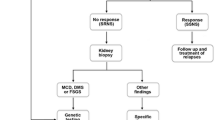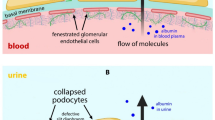Abstract
The pathogenesis of minimal change nephrotic syndrome (MCNS) is still unknown. We performed a clinical and genetic evaluation of 104 adults (mean age 35 years) who presented with MCNS in childhood (mean follow-up 30 years). Clinical data and the present health status were evaluated. Also, the genes encoding the four major slit diaphragm proteins, nephrin, podocin, Neph1 and CD2-associated protein were sequenced in 38 patients with MCNS of varying severity. MCNS presented at the mean age of 5 years, and 80% of the patients relapsed 1–28 (median 3) times during childhood. The 14 subjects (14%) who had proteinuric episodes still in adulthood had a refractory disease already as children. The participants did not show a strong tendency for allergy or immune diseases, and no familial clustering of MCNS was observed. The genetic analyses revealed heterozygous amino acid changes in nephrin and podocin in 10 of the 38 patients studied. On the other hand, the genes coding for Neph1 and CD2AP were highly conserved and no amino acid substitutions were detected. In conclusion, MCNS is a multifactorial disease, in which genetics play a minor role. Allelic variants of the podocyte proteins may, however, modify the phenotype in occasional individuals.


Similar content being viewed by others
References
Schlesinger ER, Sultz HA, Mosher WE, Feldman JG (1968) The nephrotic syndrome. Its incidence and implications for the community. Am J Dis Child 6:623–632
Feehally J, Kendell NP, Swift PG, Walls J (1985) High incidence of minimal change nephrotic syndrome in Asians. Arch Dis Child 11:1018–1020
Hodson EM, Knight JF, Willis NS, Craig JC (2000) Corticosteroid therapy in nephrotic syndrome: a meta-analysis of randomised controlled trials. Arch Dis Child 1:45–51
Trompeter RS, Lloyd BW, Hicks J, White RH, Cameron JS (1985) Long-term outcome for children with minimal-change nephrotic syndrome. Lancet 8425:368–370
Koskimies O, Vilska J, Rapola J, Hallman N (1982) Long-term outcome of primary nephrotic syndrome. Arch Dis Child 7:544–548
Lewis MA, Baildom EM, Davis N, Houston IB, Postlethwaite RJ (1989) Nephrotic syndrome: from toddlers to twenties. Lancet 8632:255–259
Fakhouri F, Bocquet N, Taupin P, Presne C, Gagnadoux MF, Landais P, et al (2003) Steroid-sensitive nephrotic syndrome: from childhood to adulthood. Am J Kidney Dis 3:550–557
van den Berg JG, Weening JJ (2004) Role of the immune system in the pathogenesis of idiopathic nephrotic syndrome. Clin Sci (Lond) 2:125–136
Grimbert P, Audard V, Remy P, Lang P, Sahali D (2003) Recent approaches to the pathogenesis of minimal-change nephrotic syndrome. Nephrol Dial Transplant 2:245–248
Cunard R, Kelly CJ (2002) T cells and minimal change disease. J Am Soc Nephrol 5:1409–1411
Mathieson PW (2003) What has the immune system got against the glomerular podocyte? Clin Exp Immunol 1:1–5
Lama G, Luongo I, Tirino G, Borriello A, Carangio C, Salsano ME (2002) T-lymphocyte populations and cytokines in childhood nephrotic syndrome. Am J Kidney Dis 5:958–965
Asanuma K, Mundel P (2003) The role of podocytes in glomerular pathobiology. Clin Exp Nephrol 4:255–259
Ly J, Alexander M, Quaggin SE (2004) A podocentric view of nephrology. Curr Opin Nephrol Hypertens 3:299–305
Pavenstadt H, Kriz W, Kretzler M (2003) Cell biology of the glomerular podocyte. Physiol Rev 1:253–307
Kestilä M, Lenkkeri U, Mannikko M, Lamerdin J, McCready P, Putaala H, et al (1998) Positionally cloned gene for a novel glomerular protein—nephrin—is mutated in congenital nephrotic syndrome. Mol Cell 4:575–582
Boute N, Gribouval O, Roselli S, Benessy F, Lee H, Fuchshuber A, et al (2000) NPHS2, encoding the glomerular protein podocin, is mutated in autosomal recessive steroid-resistant nephrotic syndrome. Nat Genet 4:349–354
Shih NY, Li J, Karpitskii V, Nguyen A, Dustin ML, Kanagawa O, et al. (1999) Congenital nephrotic syndrome in mice lacking CD2-associated protein. Science 5438:312–315
Karle SM, Uetz B, Ronner V, Glaeser L, Hildebrandt F, Fuchshuber A (2002) Novel mutations in NPHS2 detected in both familial and sporadic steroid-resistant nephrotic syndrome. J Am Soc Nephrol 2:388–393
Caridi G, Bertelli R, Carrea A, Di Duca M, Catarsi P, Artero M, et al (2001) Prevalence, genetics, and clinical features of patients carrying podocin mutations in steroid-resistant nonfamilial focal segmental glomerulosclerosis. J Am Soc Nephrol 12:2742–2746
Caridi G, Bertelli R, Di Duca M, Dagnino M, Emma F, Onetti Muda A, et al (2003) Broadening the spectrum of diseases related to podocin mutations. J Am Soc Nephrol 5:1278–1286
Winn MP (2002) Not all in the family: mutations of podocin in sporadic steroid-resistant nephrotic syndrome. J Am Soc Nephrol 2:577–579
Weber S, Gribouval O, Esquivel EL, Moriniere V, Tete MJ, Legendre C, et al (2004) NPHS2 mutation analysis shows genetic heterogeneity of steroid-resistant nephrotic syndrome and low post-transplant recurrence. Kidney Int 2:571–579
Caridi G, Bertelli R, Scolari F, Sanna-Cherchi S, Di Duca M, Ghiggeri GM (2003) Podocin mutations in sporadic focal-segmental glomerulosclerosis occurring in adulthood. Kidney Int 1:365
Frishberg Y, Rinat C, Megged O, Shapira E, Feinstein S, Raas-Rothschild A (2002) Mutations in NPHS2 encoding podocin are a prevalent cause of steroid-resistant nephrotic syndrome among Israeli-Arab children. J Am Soc Nephrol 2:400–405
Lahdenkari AT, Kestila M, Holmberg C, Koskimies O, Jalanko H (2004) Nephrin gene (NPHS1) in patients with minimal change nephrotic syndrome (MCNS). Kidney Int 5:1856–1863
Caridi G, Bertelli R, Perfumo F, Ghiggeri GM (2004) Heterozygous NPHS1 or NPHS2 mutations in responsive nephrotic syndrome and the multifactorial origin of proteinuria. Kidney Int 4:1715–1716
Heidet L, Arrondel C, Forestier L, Cohen-Solal L, Mollet G, Gutierrez B, et al (2001) Structure of the human type IV collagen gene COL4A3 and mutations in autosomal Alport syndrome. J Am Soc Nephrol 1:97–106
Patrakka J, Lahdenkari AT, Koskimies O, Holmberg C, Wartiovaara J, Jalanko H (2002) The number of podocyte slit diaphragms is decreased in minimal change nephrotic syndrome. Pediatr Res 3:349–355
Lahdenkari AT, Lounatmaa K, Patrakka J, Holmberg C, Wartiovaara J, Kestila M, et al (2004) Podocytes are firmly attached to glomerular basement membrane in kidneys with heavy proteinuria. J Am Soc Nephrol 10:2611–2618
Lenkkeri U, Mannikko M, McCready P, Lamerdin J, Gribouval O, Niaudet PM, et al (1999) Structure of the gene for congenital nephrotic syndrome of the Finnish type (NPHS1) and characterization of mutations. Am J Hum Genet 1:51–61
Kabuki N, Okugawa T, Hayakawa H, Tomizawa S, Kasahara T, Uchiyama M (1998) Influence of age at onset on the outcome of steroid-sensitive nephrotic syndrome. Pediatr Nephrol 6:467–470
Huurre TM, Aro HM, Jaakkola JJ (2004) Incidence and prevalence of asthma and allergic rhinitis: a cohort study of Finnish adolescents. J Asthma 3:311–317
Yap HK, Yip WC, Lee BW, Ho TF, Teo J, Aw SE, et al (1983) The incidence of atopy in steroid-responsive nephrotic syndrome: clinical and immunological parameters. Ann Allergy 6:590–594
Meadow SR, Sarsfield JK, Scott DG, Rajah SM (1981) Steroid-responsive nephrotic syndrome and allergy: immunological studies. Arch Dis Child 7:517–524
Yap HK, Cheung W, Murugasu B, Sim SK, Seah CC, Jordan SC (1999) Th1 and Th2 cytokine mRNA profiles in childhood nephrotic syndrome: evidence for increased IL-13 mRNA expression in relapse. J Am Soc Nephrol 3:529–537
Lin CY, Chien JW (2004) Increased interleukin-12 release from peripheral blood mononuclear cells in nephrotic phase of minimal change nephrotic syndrome. Acta Paediatr Taiwan 2:77–80
Ruf RG, Fuchshuber A, Karle SM, Lemainque A, Huck K, Wienker T, et al (2003) Identification of the first gene locus (SSNS1) for steroid-sensitive nephrotic syndrome on chromosome 2p. J Am Soc Nephrol 7:1897–1900
White RH (1973) The familial nephrotic syndrome. I. A European survey. Clin Nephrol 4:215–219
Ruf RG, Lichtenberger A, Karle SM, Haas JP, Anacleto FE, Schultheiss M, et al (2004) Patients with mutations in NPHS2 (podocin) do not respond to standard steroid treatment of nephrotic syndrome. J Am Soc Nephrol 3:722–732
Hamano Y, Grunkemeyer JA, Sudhakar A, Zeisberg M, Cosgrove D, Morello R, et al (2002) Determinants of vascular permeability in the kidney glomerulus. J Biol Chem 34:31154–31162
Huber TB, Simons M, Hartleben B, Sernetz L, Schmidts M, Gundlach E, et al (2003) Molecular basis of the functional podocin-nephrin complex: mutations in the NPHS2 gene disrupt nephrin targeting to lipid raft microdomains. Hum Mol Genet 24:3397–3405
Salant DJ, Topham PS (2003) Role of nephrin in proteinuric renal diseases. Springer Semin Immunopathol 4:423–439
Kim JM, Wu H, Green G, Winkler CA, Kopp JB, Miner JH, et al (2003) CD2-associated protein haploinsufficiency is linked to glomerular disease susceptibility. Science 5623:1298–1300
Pereira AC, Pereira AB, Mota GF, Cunha RS, Herkenhoff FL, Pollak MR, et al (2004) NPHS2 R229Q functional variant is associated with microalbuminuria in the general population. Kidney Int 3:1026–1030
Koziell A, Grech V, Hussain S, Lee G, Lenkkeri U, Tryggvason K, et al (2002) Genotype/phenotype correlations of NPHS1 and NPHS2 mutations in nephrotic syndrome advocate a functional inter-relationship in glomerular filtration. Hum Mol Genet 4:379–388
Schultheiss M, Ruf RG, Mucha BE, Wiggins R, Fuchshuber A, Lichtenberger A, et al (2004) No evidence for genotype/phenotype correlation in NPHS1 and NPHS2 mutations. Pediatr Nephrol 12:1340–1348
Beltcheva O, Martin P, Lenkkeri U, Tryggvason K (2001) Mutation spectrum in the nephrin gene (NPHS1) in congenital nephrotic syndrome. Hum Mutat 5:368–373
Tsukaguchi H, Sudhakar A, Le TC, Nguyen T, Yao J, Schwimmer JA, et al (2002) NPHS2 mutations in late-onset focal segmental glomerulosclerosis: R229Q is a common disease-associated allele. J Clin Invest 11:1659–1666
Acknowledgements
This work was supported by grants from the Finnish Academy, the Sigrid Juselius Foundation, Pediatric Research Foundation, and Helsinki University Central Hospital Research Fund.
Author information
Authors and Affiliations
Corresponding author
Additional information
Anne-Tiina Lahdenkari and Maija Suvanto contributed equally
Rights and permissions
About this article
Cite this article
Lahdenkari, AT., Suvanto, M., Kajantie, E. et al. Clinical features and outcome of childhood minimal change nephrotic syndrome: is genetics involved?. Pediatr Nephrol 20, 1073–1080 (2005). https://doi.org/10.1007/s00467-005-1965-y
Received:
Revised:
Accepted:
Published:
Issue Date:
DOI: https://doi.org/10.1007/s00467-005-1965-y




